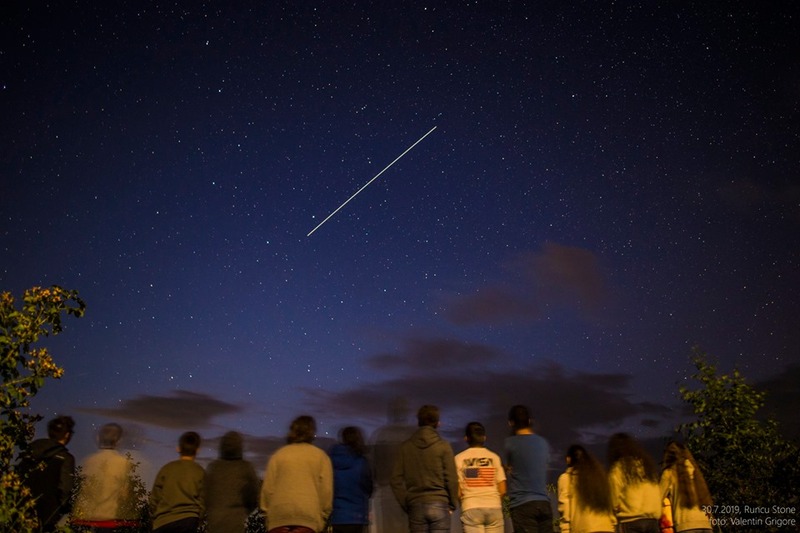HERMANN OBERTH AND THE FIRST ROCKET
IN SIGHISOARA
Text and photos Andrei Dorian Gheorghe
ISS photo Valentin Grigore
Design Florin Alexandru Stancu
Increasing Evening Moon (Bucharest 2018-05-24)...
Full Moon (Bucharest 2018-05-28)…
Decreasing Morning Moon (Bucharest 2018-06-03)…
The three visible phases of the Moon,
the heavenly body which inspired Hermann Oberth to become a scientist,
after he had read Jules Verne’s
“From the Earth to the Moon” and “Around the Moon” in his childhood.
Although born in Hermannstadt-Sibiu in 1894,
he graduated the primary school and the high school in Sighisoara
(a town with 30,000 inhabitants today),
which belonged to the Austro-Hungarian Empire at that time.
Then he lived in Germany, Romania, Switzerland and USA,
and became “one of the fathers of astronautics and rocketry”
and “the father of space navigation”,
publishing essential books
(“By Rocket into Planetary Space” in 1923,
“Ways to Spaceflight” in 1929,
“The Moon Car” in 1959 etc.)
and making a lot of decisive and brilliant things in this field
until his death (1989).
So that, more or less,
today every rocket includes something from the work of Hermann Oberth,
such as the ISS from the image from bellow,
taken by the president of SARM, Valentin Grigore (Runcu Stone 2019-07-30.

In 1923 Hermann Oberth returned to Sighisoara
(now part of the Romanian Kingdom),
teaching mathematics and physics at the local German high school for one year.
I visited Sighisoara in 2018 June
and I remained overnight at a nearby new hotel named Transylvania,
which tried to put together more elements of traditional architecture.
During the next morning I tried to guess from the distance,
through a hard fog,
the historical citadel of the town
(included in the UNESCO Heritage),
placed between the Orthodox Cathedral (down on the left from my position)
and the Lutheran Church (up on the right).
Something more…
 800.jpg)
For a few centuries,
Sighisoara was part of Konigboden, “the Land of the Royal Guests”,
the Saxons who were brought to Transylvania by the Hungarian Kings
to protect its borders and to break the connection between
the Transylvanian Romanians and those from Wallachia and Moldavia.
They named the town Schäsbrich.
Obviously, I tried to catch, from the speed of the bus,
the memorial house of Hermann Oberth.
Then I went to the central square,
which is named just after Hermann Oberth.
The citadel of the town was begun by the Transylvanian Saxons
in the 12th century,
became a favourite destination for the Hungarian aristocracy
in the 14th century
(who named it Segeshvar),
and is the seat of an annual medieval festival today.
Obviously, I visited it, knowing that Hermann Oberth
studied and taught here.
From its architectural pearls, I remember only
the Clock Tower (founded in the 13th century and improved later,
including a globe made by a giant - after a legend -
and figurines representing the days of a week,
which were added in the 17th century),
the Franciscan Church (founded in the 12th century)
and the house of Vlad Dracul (ruler of Wallachia, knight of the Dragon Order
and the father of Vlad Tepes Dracula ).
But, firstly, a solar halt…
And, later, another one…
In spite of so many beauties,
the leitmotif of Sighisoara remains the Clock Tower,
probably the first rocket in the imagination of Hermann Oberth.
Finally, I decided to end this project, like in many other cases,
with the three heavenly bodies from the Romanian coat of arms
just because,
if Germany rejected the astronautic thesis of doctorate by Hermann Oberth,
Romania accepted it at the University of Cluj in 1923,
superiorly “launching” his professional career.
So that here is the Sun
(Sighisoara 2018-06-10).
And here is the Moon with the Evening Star
(Bucharest 2018-06-07),
this time neither Venus nor Jupiter,
but Mars close to its greatest opposition in the last 15 years.
Not incidentally,
but just because the first heavenly bodies
where people sent rockets and used vehicles,
inspired in part also from the work of Hermann Oberth,
were the Moon and Mars.
*
© 2019 SARM
(Romanian Society for Meteors and Astronomy)